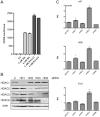Vitamin D resistance and colon cancer prevention
- PMID: 22180570
- PMCID: PMC3384070
- DOI: 10.1093/carcin/bgr301
Vitamin D resistance and colon cancer prevention
Abstract
Observational studies have been largely consistent in showing an inverse association between vitamin D and an individual's risk of developing colorectal cancer. Vitamin D protection is further supported by a range of preclinical colon cancer models, including carcinogen, genetic and dietary models. A large number of mechanistic studies in both humans and rodents point to vitamin D preventing cancer by regulating cell proliferation. Counterbalancing this mostly positive data are the results of human intervention studies in which supplemental vitamin D was found to be ineffective for reducing colon cancer risk. One explanation for these discrepancies is the timing of vitamin D intervention. It is possible that colon lesions may progress to a stage where they become unresponsive to vitamin D. Such a somatic loss in vitamin D responsiveness bears the hallmarks of an epigenetic change. Here, we review data supporting the chemopreventive effectiveness of vitamin D and discuss how gene silencing and other molecular changes somatically acquired during colon cancer development may limit the protection that may otherwise be afforded by vitamin D via dietary intervention. Finally, we discuss how understanding the mechanisms by which vitamin D protection is lost might be used to devise strategies to enhance its chemopreventive actions.
Figures



Similar articles
-
Chemoprevention of colon cancer by calcium, vitamin D and folate: molecular mechanisms.Nat Rev Cancer. 2003 Aug;3(8):601-14. doi: 10.1038/nrc1144. Nat Rev Cancer. 2003. PMID: 12894248 Review.
-
Active vitamin D potentiates the anti-neoplastic effects of calcium in the colon: A cross talk through the calcium-sensing receptor.J Steroid Biochem Mol Biol. 2016 Jan;155(Pt B):231-8. doi: 10.1016/j.jsbmb.2015.02.006. Epub 2015 Mar 7. J Steroid Biochem Mol Biol. 2016. PMID: 25758239
-
Chemoprevention of colon cancer.Cancer Treat Res. 2001;106:155-82. doi: 10.1007/978-1-4615-1657-6_7. Cancer Treat Res. 2001. PMID: 11225002 Review. No abstract available.
-
Induction of calcium sensing receptor in human colon cancer cells by calcium, vitamin D and aquamin: Promotion of a more differentiated, less malignant and indolent phenotype.Mol Carcinog. 2015 Jul;54(7):543-53. doi: 10.1002/mc.22123. Epub 2013 Dec 17. Mol Carcinog. 2015. PMID: 26076051
-
Dairy consumption and the prevention of colon cancer: is there more to the story than calcium?Am J Clin Nutr. 2006 Mar;83(3):527-8. doi: 10.1093/ajcn.83.3.527. Am J Clin Nutr. 2006. PMID: 16522897 No abstract available.
Cited by
-
Vitamin D Regulation of the Uridine Phosphorylase 1 Gene and Uridine-Induced DNA Damage in Colon in African Americans and European Americans.Gastroenterology. 2018 Oct;155(4):1192-1204.e9. doi: 10.1053/j.gastro.2018.06.049. Epub 2018 Jun 30. Gastroenterology. 2018. PMID: 29964038 Free PMC article.
-
Vitamin D Receptor Signaling and Cancer.Endocrinol Metab Clin North Am. 2017 Dec;46(4):1009-1038. doi: 10.1016/j.ecl.2017.07.007. Epub 2017 Sep 29. Endocrinol Metab Clin North Am. 2017. PMID: 29080633 Free PMC article. Review.
-
Regulation of VDR Expression in Apc-Mutant Mice, Human Colon Cancers and Adenomas.Cancer Prev Res (Phila). 2015 May;8(5):387-99. doi: 10.1158/1940-6207.CAPR-14-0371. Epub 2015 Apr 14. Cancer Prev Res (Phila). 2015. PMID: 25873367 Free PMC article.
-
Targeted delivery of 1,25-dihydroxyvitamin D3 to colon tissue and identification of a major 1,25-dihydroxyvitamin D3 glycoside from Solanumglaucophyllum plant leaves.J Steroid Biochem Mol Biol. 2015 Apr;148:318-25. doi: 10.1016/j.jsbmb.2014.10.019. Epub 2014 Nov 1. J Steroid Biochem Mol Biol. 2015. PMID: 25445916 Free PMC article. Review.
-
The renin-angiotensin system mediates EGF receptor-vitamin d receptor cross-talk in colitis-associated colon cancer.Clin Cancer Res. 2014 Nov 15;20(22):5848-5859. doi: 10.1158/1078-0432.CCR-14-0209. Epub 2014 Sep 11. Clin Cancer Res. 2014. PMID: 25212605 Free PMC article.
References
-
- Richardson,L.C. et al. (2011) Vital signs: colorectal cancer screening, incidence, and mortality—United States, 2002–2010. MMWR Morb. Mortal. Wkly Rep. 2011;60:884–889. - PubMed
-
- Nelson RS, et al. Colorectal cancer screening. Curr. Oncol. Rep. 2009;11:482–489. - PubMed
-
- Cuzick J, et al. Aspirin and non-steroidal anti-inflammatory drugs for cancer prevention: an international consensus statement. Lancet Oncol. 2009;10:501–507. - PubMed
Publication types
MeSH terms
Substances
Grants and funding
LinkOut - more resources
Full Text Sources
Medical
Molecular Biology Databases

